ICONS
AND ICONOCLASM
Why No Picture Windows in the Presbyterian Church
November, 2006
Our minister, Craig has been puzzled for some years about the mysterious inscription in the middle of the high center window on the lakeside of our church. The Adams window. Have you ever noticed the letters A and C with an ampersand joining them? They are up pretty high, and hard to make out from ground level. (Pix below left) Is it a symbol of a secret society? Is it the initials of two family members?
 |
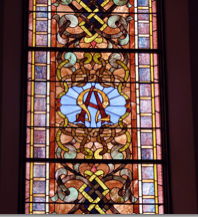 |
We have another set of initials on the west side of the church. Greek letters. An Alpha and an Omega. (Pix above right) This we understand. That's the symbol for Jesus, or the Word. Remember? "I am the Alpha and the Omega." "Before Abraham was, I am." Well, that's pretty subtle. Why don't we have a depiction of Jesus, a real likeness? Other churches have window after window of pictures of Jesus that come alive with the sunlight. Why do we have just a couple of letters from a foreign alphabet? Our windows are lovely to look at, and throw wonderful color patterns when the sun hits. Take a fresh look at a few of our windows…(views of windows)
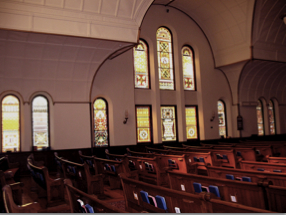 |
 |
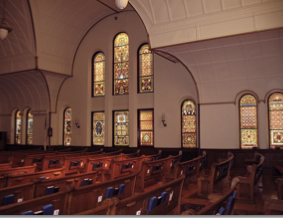 |
Come to think of it, we don't even have a statue. No saints, no holy family, no apostles. Not even Moses or Isaiah. And how about a picture of God himself – like the Sistine Chapel? There is barely a cross in sight. The most prominent object in the sanctuary is the new organ. We don't have any pictures, statues, and objects of worship - assuming the new organ is not an object of worship. In fact, there are no engraved images at all in the sanctuary. Except for the (pix) Bible, a harp, a crown, pomegranates, flowers and grapes. And some curious inscriptions. Why not?
 |
 |
 |
The answer begins about 300 AD. Solitary Christians had begun going off into the desert to find a cave or cranny where they could practice a pure ascetic Christianity. These early Coptic Christians were on fire with the love of Christ and zeal for self-purification. The largest center of this "hermit" acitivity was in Scete, outside Alexandria, in Egypt.
We pick up the tale of the broken icons about four or five hundred years later, in the middle of the 8th Century. In Constantinople, now Istanbul, the Emperor of the Byzantine Empire was having bad luck with his army fighting the Muslims. Imagine that. Emperor Leo III was suffering military reversals. There was no press corps or congress to bad-mouth. Leo was absolute ruler. It happened that over the gates of Constantinople was a large image of Jesus. (PIX)
| Leo, perhaps angry with the Christian God for his bad run of luck, or maybe just needing a scapegoat, had the image taken down. This was the first recorded iconoclasm in Christian church history. An iconoclast is literally an image breaker. The Greek Klasm – break, Icon – image. Leo III wasn't an indiscriminant iconoclast. Images in general didn't bother him. Leo didn't take down crosses, or more significantly, images of Emperor Leo. He was after Jesus, not images. Leo consulted no one for his action. No Pope, Metropolitan, bishop or deacon. Clear separation of Church and State, with State running the show. |
Not surprising, there was some opposition to this, among them the then Patriarch of Constantinople. His opposition was not so much that image worship was right or wrong, but that any change would weaken the faith. Tradition, tradition. A whistle blower, he was soon out of a job. The Pope in the West condemned Leo's action. Several councils were held in the latter part of the 8th Century, and the last, the Second Council of Nicea, condemned iconoclasm and encouraged the use of images in worship. Thus ended the second battle of the images.
Although the rift between the Western Church and the Eastern Church stands to this day, both the Roman Catholic Church and the Orthodox Churches in the East are united in affirmation of the use of icons in worship.
Leo's rationale for the first iconoclasm – not that he needed one – was the 2nd commandment, "You shall not make for yourself a graven image, or any likeness of anything that is in heaven above, or that is in the earth beneath, or that is in the water under the earth; you shall not bow down to them or serve them…"
This commandment is the basis on which many but not all Protestant churches reject iconography, statues and even crosses. And is the basis for why there are no pictures in our windows. This commandment follows the first; "I am the Lord, your God, who brought you out of the land of Egypt, out of the house of bondage. You shall have no other gods before me."
There is some disagreement across religious traditions on where the first commandment ends, and the second commandment begins. The Jews take the first sentence as the first commandment. It is a statement of God's existence and that God is a God of action. , "I am the Lord, your God, who brought you out of the land of Egypt, out of the house of bondage."
Whichever you conclude, the second commandment about making graven images or idols ends with the phrase; "you shall not bow down to them or serve them…"
So, the debate, even within Protestantism, is whether the prohibition is against making a statue or an image or a picture, or whether the prohibition is against worshipping a picture or image or statue as an animate god in itself. We have prominent men on both sides of the argument. One of the founders of Protestantism, Martin Luther, was quite comfortable with the veneration of icons. Luther felt Christians should feel free to use religious images in worship, as long as they didn't worship the images instead of worshipping God. Other Protestant leaders, such as our own Presbyterian John Calvin, were quite broad, or liberal in interpretation. Calvin even felt the scene in Exodus, in the desert, when Moses lifted up the "brazen image" of a snake as a cure for the plague of snakes biting the people, was a form of worship. Worshipping the image as a representative of God. He seemed to have thus condemned it – and coincidently Moses, who scripture tells us, was instructed by God to do this. Incidentally, the symbol of the brazen snake lifted up is used to this day by the American Medical Association as the symbol of healing.
Has anyone here been to Chartres, or the cathedral at Rheims? You noticed the great cathedrals are covered with statues. These images and statues have traditionally been used to teach. Until recent years, most people were illiterate. Even if the scriptures had been translated into plain language, most people would not have been able to read it. So, the use of statues, scenes liberally "carved in stone" around the church or cathedral, were a way of letting people learn - and be reminded of the stories of the Bible. You visitors to the great cathedrals of Europe have probably been with a tour guide who "read" the cathedral to your group.
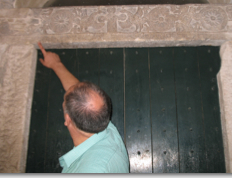 |
We were just touring parts of Croatia, which has many medieval churches. In the ancient walled city of Trogier we had a very competent guide show us the town. (left) And he read both the local church and the cathedral to us. | ||
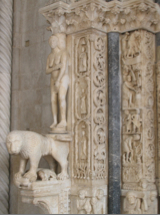 |
Here is a very earthy read of Eve and Adam, and the characters in the story. Notice they are set up at the left and right of the doorway, symbolic of the Old Testament two pillars of right and wrong set up at the front of Solomon's original Temple. Notice Adam's hand, the other one, on his throat. Our male Croatian guide's read on this was Adam tried to spit out the apple Eve gave him, but too late. The bite of Adam's apple got permanently stuck in his – and our - throat. Eve is looking chagrined. |  |
Let me go off topic for a moment. In the Protestant tradition, we generally avoid "illustrations" in a serious way. No pictures in the windows or statues in or near the church. But, our Christian Ed is a different matter. Our coloring books for kids, and illustrated children's Bible stories, for example, subvert the theological purpose of not showing images of God or Jesus, Mary or Joseph. This is not a complaint or accusation. It's just that our teachers and authors understand that pictures are a wonderful and time-honored way to teach. Even to teach adults. We have a phrase, "A picture is worth a thousand words." Maybe a million words, when the words are high-falluting or contentious. But images register. More than register, they communicate clearly, and have the power to evoke thought. Whether it's junk television or an Old Master, images have a role in human discourse. We allow our children to be flooded with images every day. It puzzles me why they are excluded from selected zones of the most important human issue for our children – and us – our spiritual development.
Tradition is the main answer to this contradiction. To quote Thomas Keating, a master of inter-religious dialogue on tradition;
I find that inter-religious dialogue liberates one from aspects of one's own tradition that are largely cultural and not the essence of the revelation. These have become so intermingled with the essence over the centuries that one cannot easily discern the difference.
Lets consider the original icons. (PIX – Holy Trinity Rublev, Russia, 15th Century)
What is the religious experience when one "reads" or prays an icon? Do we worship it? No. First we are instructed to "gaze" at the icon. Not stare at it. Gazing is part of the Greek, Russian and Eastern Orthodox traditions. For example as we gaze at this icon to read it, we are led into a consideration of the Holy Trinity. We see the Father's movement towards the Son, in the center. We see both the Holy Spirit, on the right of the circle, looking to the Father, as does the Son. Jesus has the central role in this drama. In the center of the altar/table is a representation of the sacrificial lamb. Jesus, signaling with two fingers indicates his dual nature and role. The small rectangle low on the front of the altar beneath the lamb, shows the narrow way to the house of God, behind on the hill, past the tree of life. We notice the arrangement of figures represents both a cross and a circle, the two symbols of eternity and our route. This same icon also evokes the three angels in Genesis, who visited and announced the birth of Isaac to Abraham and Sarah. And as we consider these thoughts in a "side-long gaze" we find our thoughts become prayerfully transported. Not to the figures in the picture, but to what is beyond them. This can be the beginning of contemplation.
This is what is meant by a worship aide. We all often use photographs as memory aids. When we see a wonderful old picture of our great-grandmother, and experience emotions and connection, can we say that we are confusing the photograph with the great-grandmother? I think most would agree the photo is just an aid to memory, and a focuser of emotion and experience. In the same way, users of icons would not regard the icon as the object of worship, but as an aid to worship. They venerate the icon, but do not worship it. As we venerate the cracked and faded photo of our great-grandmother, but do not worship it. They find icons a focuser of spiritual worship, as we find the photo a focuser of family emotions.
Speaking of which, here are some old pictures of Jewish Rabbis.
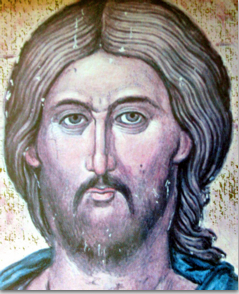 |
 |
The one on the right is my
great-grandfather. While I was born after he died, I am grateful
he honored and kept the Original Covenant – which
by the way, was never revoked. His faithful preserving of the Old Testament
prepared me to choose the New Covenant as my agreement with God. Which
is why I can speak to you as a Christian today.
But, back to the puzzle we started off with. The A&C (or C&A) in our stained glass window. There it sits, above the center of the entrance to the sanctuary, right in the middle of the center window. This can't be accidental. Here's a thought; around the turn of the century serious Presbyterians continued to wrestle over the notions of Arminianism and Calvinism. It was often framed as Arminianism versus Calvinism. Free will versus pre-destination. In brief, if God is omniscient, He knows the answer before it happens, and moreover, Jesus said we must be called to be saved. Predestination was the essence of John Calvin's theology – John Calvin being the founder of the Presbyterian Denomination. That is, the elect have been pre-destined by God for salvation. This is of course a form of determinism. Arminianism is named for a Dutchman who emphasized the freedom of will of an individual by whose movements of faith, combined with the grace of God, enabled salvation. There is nothing pre-determined about it.
This was - and in some circles still is - a very divisive issue. Perhaps the Adams family felt a reconciliation of these seemingly opposed views was not just possible, but important. Maybe they felt it was unseemly for humans to try and parse the great mystery of election and will as if it could be fully understood and decided by debate. If that were in their minds, it would be a fitting testament to leave a subtle symbol of the "conjoining" of these two seemingly opposed points of doctrine, Arminianism AND Calvinism (A & C, not A or C), right at the head of this solid brick church at the head of this extraordinary lake.
Maybe yes, maybe no. And there are other theories. But, as we finish up, to carry the integrating thought a little further, as you all know, Central New York State was a key locale for spiritual stirring in America long before Christian Science, Abolition, the Women's Movement and Mormonism were born here. The Onondaga Indian tribe was the central nation of the Five Iroquois Nations, sort of a spiritual anchor of that pre-Columbian civilization that preceded us here. This lake may even have been the "spirit lake" located as it is in the center of the Five Nations. You could even entertain the thought that the churches here at the head of this magical lake may continue to be a central spiritual anchor for the larger community and church in this unusual time in history.
I'm glad Christ is now worshipped here in this sacred spot. Jesus Christ the Lord is powerfully preached here, even if our tradition leads us to not put up pictures of Him, or his Mom or Step-Dad on our walls or in our glorious windows. Speaking of glorious windows, here's one – the only one – at St. Benedict's Monastery in Old Snowmass, Colorado, where I was on Trappist Retreat last week. It's a baby picture of Our Lord with his Mom.
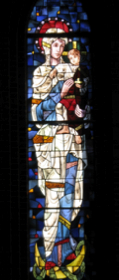 |
And now it's time for your views…